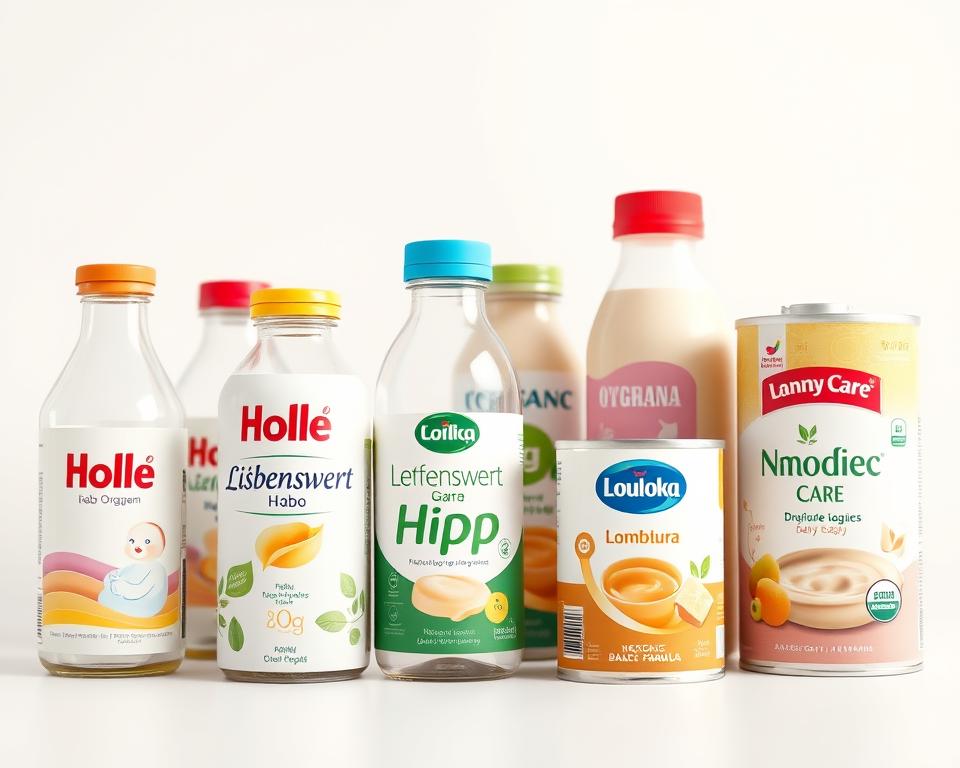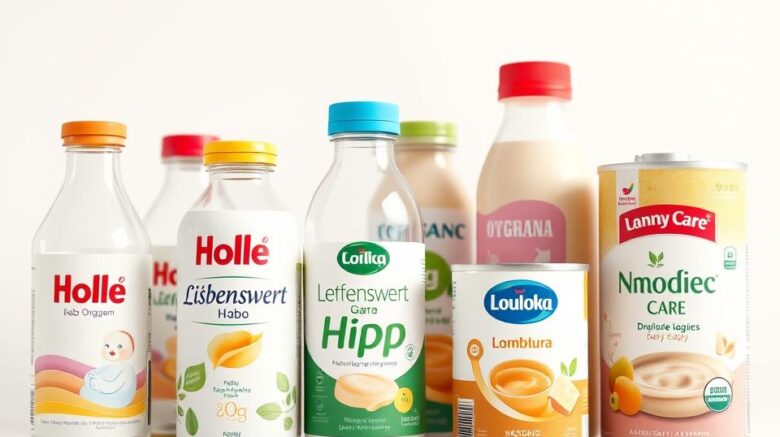Uncover the Best Organic Formula Options: A Parent’s Guide
Almost eight in ten U.S. moms and dads rely on formula during their baby’s first year. Lactation difficulties frequently cause this shift. Selecting the proper organic formula milk proves crucial for such households. Our handbook helps caregivers choose the optimum organic formula for their little ones.
We will examine various formulas and brands, focusing on quality and nutrition. This information is vital for ensuring a healthy start for your child.
Deciding on infant nourishment ranks among the most important parental tasks. Organic infant formula has gained popularity due to its focus on organic ingredients. It provides a healthier option for infants. Free from artificial pesticides and fertilizers, they offer infants a purer beginning.
Caregivers now prioritize non-GMO, additive-free options. These worries underscore why organic formulas are the preferred safe option.
Advantages of Certified Organic Components
Certified organic components deliver notable advantages. Rigorous inspections guarantee their premium standards and security. Picking organic varieties lets caregivers know their baby avoids toxic residues.
These agricultural standards promote long-term environmental health. This reinforces benefits that extend beyond dietary choices.
Linked Wellness Benefits
These formulas may foster healthier developmental results. Many studies suggest that babies receiving organic nutrition may exhibit fewer gastrointestinal issues and a lower likelihood of allergies. This can be attributed to the pure formulation free from synthetic additives.
Caregivers appreciate the peace of mind from these well-rounded formulas. They bolster development and holistic infant health.

Essential Criteria for Choosing Organic Formula
Selecting premier organic infant formula matters dramatically for your child’s wellbeing. Assess protein types alongside key nutritional elements. Protein composition and proportions influence digestibility and nutrient uptake. Also, knowing the essential nutrients ensures your baby gets the best support for growth and development.
Whey vs. Casein Balance
Formulas typically blend whey with casein proteins. Whey breaks down quickly and casein releases nutrients gradually. A whey-lean blend suits delicate infant digestion. Many organic options boost whey content for digestive comfort. Inspect labels for detailed whey-casein info and harmonious ratios.
Essential Nutrients and Additives
Core vitamins and minerals matter for infant growth. DHA/ARA essential for cognitive and ocular growth. Prebiotic content promotes balanced digestion and a robust immune response. Look out for these components to secure complete nourishment. Organic formulas that focus on these nutrients offer a rich source of nutrition.
| Protein Source | Benefits | Whey-to-Casein Ratio |
|---|---|---|
| Whey | Easier digestibility|Gentle on tummies|Quick absorption | Higher ratio is better|Lean whey blend preferred|Above 60% ideal |
| Casein | Slow release of nutrients|Sustained nourishment|Stomach-friendly over time | Lower ratio preferred in early months|Casein kept minimal|Around 40% or less |
Popular Organic Baby Formula Brands
Moms and dads rely on established brands when buying organics. Let’s explore some top choices, highlighting their unique features and standout qualities. They lead the organic formula market, serving diverse dietary demands.
Kendamil: The Whole Milk Option
Kendamil is unique as the only organic baby formula made with whole milk. Enjoy its luscious consistency free from unwanted chemicals. Caregivers favor it for its simple, clean ingredients. Ordering Kendamil via the web is easy and rapid.
HiPP Combiotik: The Gentle Choice for Sensitive Tummies
Engineered for delicate tummies, HiPP Combiotik minimizes distress. Features both prebiotics and probiotics for digestive support. Caregivers rely on HiPP’s quality for peace of mind at organic retailers.
Holle’s Biodynamic Organic Formula
Famed for biodynamic standards, Holle Bio ensures top-quality organics. Strict testing and eco-focused practices define its excellence. Parents trust Holle for its authentic taste and nutrition.
Aussie Bubs: The Grass-Fed Option
Aussie Bubs is notable for using grass-fed cow ingredients, ensuring high nutritional value. Ingredients mirror a holistic, pasture-based ethos. This distinct sourcing helps caregivers identify premium organics.
Bobbie’s Forward-Looking Formula
Bobbie is at the forefront of baby nutrition, blending modernity with thoughtful formulation. Fulfills today’s nutritional guidelines alongside organic purity. Moms and dads trust Bobbie for its evidence-based, organic formula.
Choosing the right organic formula for your baby requires careful thought about their dietary needs. Accounting for sensitivities ensures a comfortable feeding experience. Component choices matter for infants prone to digestive issues.
Evaluating Food Sensitivities
Many infants have dietary sensitivities, leading to reactions to certain formula components. It’s vital to seek out products tailored to these needs. Sensitive blends reduce lactose or include pre-broken down proteins. These features aim to reduce irritation and aid in digestive health.
Always consult a pediatrician to determine the most suitable formula for your baby’s specific needs.
Prioritizing Gut Ease
Digestive comfort is essential for infants, and the right organic formula is key. These compounds encourage a healthy microbiome and smoother digestion. Supporting microbial balance leads to better digestion and utilization of nutrients.
Mothers supplementing with formula can find options mimicking breast milk nutrients.
Steps to Switch to Organic Formula
You can transition infants from breastfeeding or standard formula to organic smoothly. Grasping best practices eases the process for you and baby. Gradual changes are key to a smooth transition and help your baby accept the organic formula.
Steps for a Smooth Transition
First, add a bit of organic formula to your usual blend. Use this plan for the gentlest switch:
- Begin with a mix of your current formula and organic baby formula, using a ratio of about 25% organic to 75% traditional formula.
- Slowly tilt the balance until you reach 100% organic.
- If distress appears, reduce the organic increment and proceed more slowly.
- Offer the organic baby formula at controlled times during the day to help your baby associate it positively.
- Keep consistent feeding times to support the changeover.
Indicators of Successful Switching
Spotting these indicators confirms a smooth adaptation:
- Your baby feeds comfortably without fussiness.
- Stool patterns stay even, and digestion remains smooth.
- Hunger levels and feeding frequency stay stable.
- Infant seems satisfied and relaxed post-feeding.
Though gradual, these cues show your baby is thriving on the new formula.
Comparing Organic and Regular Custom Formulas
Caregivers often debate organics versus conventional formula for baby’s diet. This decision is critical for understanding which option best meets their baby’s dietary needs. The focus on ingredient safety and health benefits often guides their choice in this important aspect of parenting.
Composition Breakdown
Ingredient lists mark the key divergence between organics and regular formulas. They feature only certified organic elements, omitting artificial chemicals. Names like HiPP, Kendamil partner with organic producers for premium milk. On the other hand, traditional formulas might include synthetic nutrients or non-organic ingredients. It explains why caregivers favor organics for a natural approach.
Cost Comparison
Organic formulas generally carry premium pricing because of certification expenses. These formulas cost more because of strict organic compliance fees. Families consider the premium a small price for superior safety and nutrition. Assessing cost versus benefit guides a balanced purchasing decision.
Digital retailers have transformed organic formula purchasing. Caregivers order premium blends with a few clicks. This change broadens access to a wider variety of brands and formulas, meeting diverse dietary requirements.
Benefits of Online Shopping
E-commerce fits into jam-packed daily routines. Easy ordering from any location.
- Ease of access
- Broad brand offerings via online catalogs
- Online deals and sales help reduce costs
Subscription Services Explained
Infant formula subscription services have become increasingly popular. Set-and-forget deliveries ensure you never run out.
Key features of infant formula subscriptions include:
- Regular shipments keep cabinets full
- Set delivery intervals to match your consumption rate
- Subscription rates often beat retail prices
Regulatory Standards for Organic Baby Formulas
Ensuring the safety and quality of organic baby formulas is a complex task. It involves a detailed framework of regulatory standards. FDA mandates safeguard formula nutrient profiles and hygiene. The USDA organic certification, on the other hand, verifies the authenticity of organic claims. Awareness of regulations boosts caregiver confidence.
Federal Formula Guidelines
The Food and Drug Administration sets essential formula rules. They specify exact nutrient amounts and ingredient safety limits. This ensures that each formula meets the nutritional needs of a growing baby. Main elements are:
- Mandatory ingredient listings|Required ingredient disclosures|Compulsory component labeling
- Specific nutrient requirements such as protein, fats, and vitamins|Defined macro- and micronutrient thresholds|Preset nutrition minimums
- Comprehensive quality control measures during manufacturing|Rigorous production inspections|Stringent safety checks
Following these rules means infants receive only approved formulas.
USDA Organic Requirements
These certifications confirm true organic sourcing and handling. It includes multiple verification steps to ensure compliance. Key criteria include:
- Proof that ingredients are produced without synthetic fertilizers or pesticides|No chemical fertilizers or sprays used|Farm inputs must be 100% natural
- Verification of non-GMO (genetically modified organism) status|Guarantee of GMO-free sourcing|Strict non-GMO testing
- Clear guidelines on the handling and processing of organic products|Protected organic integrity during production|Certified organic processing rules
USDA label confirms field-to-formula organics. This promotes healthier options for infants. The combination of USDA certification with FDA regulations provides parents with confidence in their baby’s nutrition.
| Regulatory Aspect | Description |
|---|---|
| FDA Regulations | Sets safety and nutrient standards for infant formula |
| USDA Organic Certification | Ensures organic ingredients are grown without harmful substances |
| Quality Control | Mandatory checks during production processes |
| Ingredient Transparency | Clear labeling of all components for consumer knowledge |
Buying Guide for Organic Formulas
Selecting the optimal organic formula might feel overwhelming. Yet, armed with smart strategies, selection becomes simple. Knowing where to shop and what to look for in labels makes the process smoother.
Best E-Tailers for Organic Formula
Numerous reputable e-retailers stock certified organics. They often have competitive prices. Here are some top choices:
- Amazon – Known for its wide variety and fast shipping
- Target – Features same-day delivery and curbside pickup
- Walmart – Combines web ordering and brick-and-mortar access
- Thrive Market – Focuses on health-conscious products, including organic options
Check user feedback and ratings first. They help assess the product’s quality and the retailer’s reliability.
Understanding Labeling and Certifications
Knowing label terminology ensures you get true organics. Seek official seals verifying organic compliance. Typical certifications are:
| Certification | Description |
|---|---|
| USDA Organic | Indicates the formula contains at least 95% organic ingredients |
| Non-GMO Project Verified | Means the formula does not use genetically modified organisms |
| European Union Organic | Denotes adherence to EU organic farming regulations |
Recognizing seals guarantees purity and health.
Bringing It All Together
To wrap up, careful formula selection supports optimal baby development. Organics bring peace of mind beyond mere nutrition. It provides vital nutrients without harmful additives. Caregivers now know to check protein ratios, sensitivity profiles, and top names like Kendamil and Holle.
We emphasized matching formula to individual infant requirements. Moving to organic formulas calls for a stepwise plan. Incremental change safeguards digestive ease.
Guided by these pointers, you’ll choose with confidence from many choices. Choosing organics lays a foundation for enduring wellness. Let’s continue to prioritize quality nutrition for our babies. We should support them with the best possible choices as they begin their food journey.
